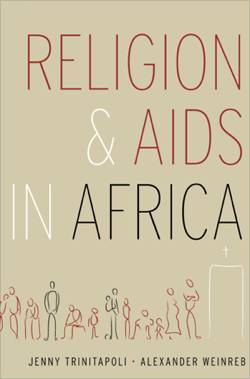
The sociologists base much of their fieldwork in Malawi but also draw on surveys from other sub-Saharan African countries. They challenge the idea that African religious leaders share a common perception of AIDS as a judgment of sinful behavior. Although this is a popular view, they find, for instance, that the fast-growing Pentecostals, who are thought to be the most embracing of this idea, actually were least likely (compared to such groups as Muslims, Catholics, and African Independents) to say that the sexually immoral deserve the disease. Even those using judgmental themes tend to combine them with powerful ministries to the infected, dying, and orphans. Without strong societal safety nets, these religious organizations are crucial in extending treatment and preventive measures to Africans.
As for the prevention of AIDS, the authors find that the “ABC plan” (abstinence, being faithful, using condoms) is often effective and widely practiced. Those congregations that combine bio-medical and moral approaches (such as found in the ABC plan) tend to have lower rates of HIV prevalence while those congregations with an emphasis on faith healing tend to have higher rates-yet it is the latter types of congregations that are growing most rapidly. Using religious messages to support abstinence tends to be more effective than using instrumental motivations, such as asking young people to abstain so they can attend college or have fulfilling careers, mainly because of the poverty in these societies and the difficulty poor people have in fulfilling such aspirations. In contrast, religious messages are based on universal claims that have a stronger moral force on individual behavior. While abstinence is difficult, the book finds that abstinence rates among African teens (ranging from a high 85 percent in Ghana to 64 percent in Malawi) are considerably higher than the rates reported among American high school students (52 percent).
On condom use, the researchers found several anomalies related to religion. The practice tends to be lower among Muslims than other religious groups, even though Islamic leaders don’t prohibit the practice. In contrast to Western media reports alleging that religion is a barrier to HIV prevention, Trinitapoli and Weinreb found that religious leaders were among the first in sub-Saharan Africa to legitimize the use of condoms. Despite official condemnation of the practice, condom use among Catholics is at a similar rate to other believers; the researchers point to congregational distribution of condoms in Catholic parishes across South Africa. The book points to other “local,” non-ABC strategies that some religions use, such as encouraging early marriage, being more accepting of divorce (its increasing frequency limits spreading AIDS among married couples, according to research) and discouraging alcohol use.
The last chapter turns the tables on things, looking at the effects of AIDS on religion. The authors find that religious switching has grown, favoring those groups that stress prevention and healing ministries (notably Pentecostals and African Independent Churches), even if the switchers themselves rarely mention AIDS as a motivation for their religious change. They also find that the growth of “born again Christianity” tracks closely with the spread of the disease in rural communities. Trinitapoli and Weinreb conclude with the simple but urgent message that Western policymakers, journalists, and scholars need to give to come to terms with the way Africans use their faiths to prevent and alleviate the suffering brought on by the AIDS epidemic.
Richard Cimino
Jenny Trinitapoli and Alexander Weinreb , Religion and AIDS in Africa , Oxford University Press, 2012, 296 p.
Richard Cimino is the founder and editor of Religion Watch, a newsletter monitoring trends in contemporary religion. Since January 2008, Religion Watch is published by Religioscope Institute. Website: www.religionwatch.com.